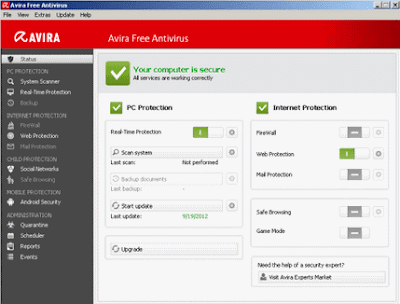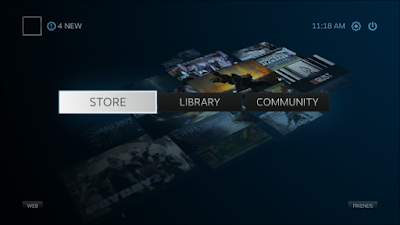Avast Free Antivirus
Avast Free Antivirus includes a DynaGen-powered intelligent antivirus. You can update it in real time. You can fix various problems without uninstalling previous antivirus. It has Remote Assistance also. It has Anti-malware Protection plus anti-spyware & anti-rootkit too. It Protects your PC against the latest viruses and spywares. It has an improved firewall for network or internet protection.AVG Free Antivirus
AVG AntiVirus is a free antivirus that gives you the antivirus protection and various security features. It has a smart scanning technology that reduces scan times. It has privacy features that keep your personal information safe both online and on your PC. It has an integrated File Shredder that permanently deletes sensitive files. It has Anti-Spyware Technology and WiFi Guard also.Ad-Aware Free Antivirus +
Ad-Aware Free Antivirus provides core protection against internet threats. It has real-time antivirus and anti-spyware engines, rootkit protection, download protection and web filters for safe browsing. It provides complete anti-malware protection. You can uninstall all third-party toolbars installed in browsers like Chrome, Firefox, IE easily. It is easy to download, install and use.Avira Free Antivirus
Avira Free Antivirus is a free antivirus and it eliminates many forms of malware including worms, rootkits, and dialers. It has various features including system scanner that prevents infection from viruses, worms, and Trojans. It blocks new viruses before they run and halts unknown code that looks suspicious.Microsoft Security Essentials
Microsoft Security Essentials is a free antivirus software for your PC. This freeware protects your computer against malwares, spywares and viruses through real time protection. It lets you run various types of scans such as Quick scan, Full scan and Custom scan. Microsoft Security Essentials has a new technology called Dynamic signature service which automatically updates when it detects a threat. When the icon of this freeware is green, then your PC is protected.Panda Cloud Antivirus
Panda Cloud Antivirus is a free and handy antivirus software. It is connected to Panda Lab’s online collective intelligence servers in real-time. This freeware is specially developed and designed to protect your computer against the latest malware, spyware and viruses. It updates automatically in the background. It lets you offer quick and custom scan for specific drives, files and folder. Panda Cloud Antivirus gives you a report of threats removed and detected from your PC for: last month, last week, last 24 hours and all.HerdProtect
HerdProtect is a free online malware scanner for your computer. It scans for the malicious software in your PC using the search algorithms of 68 popular and effective anti-virus software through the cloud. It basically makes a secure tunnel and connects to the online cloud server to scan each file in your PC and provides you the latest results from different anti-malware software.Kingsoft Antivirus
Kingsoft Antivirus is a free antivirus software having various features such as cloud scanning, system vulnerability detection, virus infection prevention and scanning etc. This freeware will scan different areas of the system for detection of viruses. It will check various parts of the system such as browser plug-ins and add-ons, system services and drivers, currently running processes, startup programs and applications and boot sector of the hard disk.VirCleaner
VirCleaner is a free tool for removal of virus from your PC. If your PC is not fully safe from viruses, then it will not run well and its gives rise to serious issues. Therefore a virus removal tool is must for every PC. It protects your PC from suspicious files, viruses and threats. It provides real-time protection to your computer. Installation is not required for this freeware.
Baidu Antivirus
Baidu Antivirus is a free antivirus application. It includes three antivirus engines: Baidu Cloud, Baidu and Avira. Baidu Antivirus will reduce phishing attacks and various other scams. It provides real-time protection to your computer. Baidu Antivirus updates quickly and provides latest antivirus definitions for your PC. This freeware protects your computer against viruses, Trojans and worms.
Bitdefender Antivirus Free Edition
Bitdefender Antivirus Free Edition is a free antivirus software for your computer. Its main features are virus shield and auto scan. It will uses famous Bitdefender technology to protect your PC from viruses, Trojans and worms. It is a lightweight application. Bitdefender Antivirus Free Edition will only scan your PC when the system resources of your PC are ideal.
ZoneAlarm Free Antivirus Plus Firewall
ZoneAlarm Free Antivirus Plus Firewall is a free antivirus cum firewall software for your computer. It protects your PC from internet threats, hackers, phishers, worms, Trojan horses, spyware and viruses. This freeware automatically scans your PC once a week. But you will also perform the manual scan by configuring its settings.Roboscan
Roboscan is a free antivirus software. It offers antivirus and antispyware protection to you in real time. To scan your PC with this freeware you can choose from three types of scans. Quick scan, basic scan and advanced scan. It also includes system status scanner, privacy scanner, self protection and firewall protection.ClamWin
ClamWin is a free antivirus application to protect your PC from malicious threats, malware, Trojans and viruses through on demand file scanning process. This freeware comes with virus database, scanner and scheduler. The main disadvantage of this free tool is that it does not provide URL scanning or access scanning option. It will regularly update its virus database.Immunet Free Antivirus
Immunet Free Antivirus is a handy and free antivirus software to protect your computer from viruses, malware and online threats without downloading another virus removing application on your PC. It provides real-time protection to your PC. Immunet Free Antivirus is a lightweight application. To update virus definitions you need to connect to Immunet Cloud.Comodo Antivirus
Comodo Antivirus is a free antivirus software to remove internet threats, hackers, worms, Trojans, malware and viruses from your PC. It is an intelligent virus protection system that offers hi-tech protection against various known and unknown threats. Comodo Antivirus updates automatically in the background and provides real-time protection to your computer.X-Ray
X-Ray is a free virus scanner software to let you analyse virus effected files by 35 antivirus companies (ViRobot, Vipre, VBA32, TrendMicro, TotalDefense, Symantec, Superantisypware, Sophos, Rising, PC Tools, Panda, nProtect, Norman, Microsoft, McAfee, Kingsoft, Kaspersky, K7antivirus, Ikaurs, Hacksoft, Fortinent, F-secure, F-prot, ESET, Emsisoft, Dr. Web, Comodo, ClamAV, QuickHeal, Bitdefender, Avira, AVG, Avast, Antiy Labs, Agnitum). All these companies send you the reports based upon the analysis of these virus effected files.VIPRE Rescue
VIPRE Rescue is a free antivirus software to clean and remove viruses from your computer. It will automatically scan your PC and does rootkit scanning as well. If you are not able to boot into windows due to virus problem then in that case boot your computer into safe mode and run this utility from command prompt. And it will effectively remove viruses from your computer.Zillya! Antivirus
Zillya Antivirus is a freeware to remove and detect all kinds of malware, rootkits, Trojans, worms and viruses that cause errors in your computer, make your computer fail, decrease performance and access to 3rd parties user’s data. This freeware also detects and eliminates adware and spyware software. Zillya Antivirus also cleans and scans your email attachments to ensure virus free mail.To read more about the different anti-viruses, visit the website http://listoffreeware.com/list-best-free-antivirus-software/, for more information.
Source: http://listoffreeware.com/list-best-free-antivirus-software/
































































